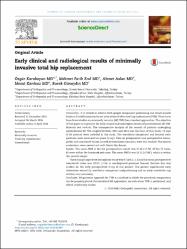| dc.contributor.author | Karakoyun, Özgür | |
| dc.contributor.author | Erol, Mehmet Fatih | |
| dc.contributor.author | Aslan, A. | |
| dc.contributor.author | Karıksız, M. | |
| dc.contributor.author | Günaydın, Burak | |
| dc.date.accessioned | 2022-05-11T14:36:12Z | |
| dc.date.available | 2022-05-11T14:36:12Z | |
| dc.date.issued | 2016 | |
| dc.identifier.issn | 0976-5662 | |
| dc.identifier.uri | https://doi.org/10.1016/j.jcot.2016.03.003 | |
| dc.identifier.uri | https://hdl.handle.net/20.500.11776/8407 | |
| dc.description.abstract | Introduction It is critical to achieve both proper component positioning and intact muscle balance if satisfactory results are to be attained after total hip replacement (THR). There have been fewer studies on minimally invasive (MI) THR than standard approaches. The objective of this paper is to present the early clinical and radiological results of posterolateral MI THR. Materials and methods The retrospective analysis of the records of patients undergoing posterolateral MI THR surgery between 2011 and 2014 was the basis of this study. 73 hips of 68 patients were included in the study. The acetabular component and femoral stem positions were measured on plane X-rays. Data on preoperative and postoperative hemoglobin and hematocrit values, as well as transfusion amounts, were also studied. The clinical evaluations were carried out with Harris Hip Scores. Results The mean HHS at the 3rd postoperative month was 87.60 (±7.70). Of the 73 cases, 61 were within the Lewinnek safe zone. The mean PMFA was 88.12 (±7.63°), which is within the normal ranges. The mean postoperative hemoglobin value was 9.7 g/dl (±1.3) and the mean postoperative hematocrit value was 29.8% (±3.8). A nondisplaced proximal femoral fracture line was evident on the early postoperative X-ray of one patient. One patient experienced early dislocation caused by acetabular component malpositioning and an early acetabular cup revision was necessary. Conclusion MI posterior approach for THR is a method in which the prosthetic components can be properly placed. Posterolateral MI approaches are safe when THR is performed, and afford satisfactory results. © 2016 Delhi Orthopedic Association | en_US |
| dc.language.iso | eng | en_US |
| dc.publisher | Elsevier B.V. | en_US |
| dc.identifier.doi | 10.1016/j.jcot.2016.03.003 | |
| dc.rights | info:eu-repo/semantics/openAccess | en_US |
| dc.subject | Coxarthrosis | en_US |
| dc.subject | Minimally invasive | en_US |
| dc.subject | Total hip replacement | en_US |
| dc.subject | hemoglobin | en_US |
| dc.subject | acetabulum | en_US |
| dc.subject | adult | en_US |
| dc.subject | Article | en_US |
| dc.subject | controlled study | en_US |
| dc.subject | femur | en_US |
| dc.subject | Harris hip score | en_US |
| dc.subject | hematocrit | en_US |
| dc.subject | hip radiography | en_US |
| dc.subject | human | en_US |
| dc.subject | major clinical study | en_US |
| dc.subject | minimally invasive surgery | en_US |
| dc.subject | postoperative period | en_US |
| dc.subject | priority journal | en_US |
| dc.subject | total hip prosthesis | en_US |
| dc.title | Early clinical and radiological results of minimally invasive total hip replacement | en_US |
| dc.type | article | en_US |
| dc.relation.ispartof | Journal of Clinical Orthopaedics and Trauma | en_US |
| dc.department | Fakülteler, Tıp Fakültesi, Cerrahi Tıp Bilimleri Bölümü, Ortopedi ve Travmatoloji Ana Bilim Dalı | en_US |
| dc.identifier.volume | 7 | en_US |
| dc.identifier.startpage | 210 | en_US |
| dc.identifier.endpage | 214 | en_US |
| dc.institutionauthor | Karakoyun, Özgür | |
| dc.institutionauthor | Erol, Mehmet Fatih | |
| dc.institutionauthor | Karıksız, M. | |
| dc.relation.publicationcategory | Makale - Uluslararası Hakemli Dergi - Kurum Öğretim Elemanı | en_US |
| dc.authorscopusid | 26967708000 | |
| dc.authorscopusid | 56911998800 | |
| dc.authorscopusid | 22957320400 | |
| dc.authorscopusid | 57189868300 | |
| dc.authorscopusid | 56421955000 | |
| dc.identifier.scopus | 2-s2.0-84975466009 | en_US |



















